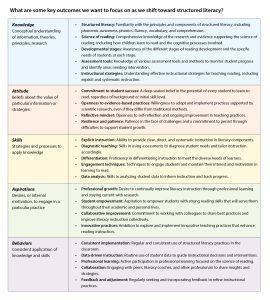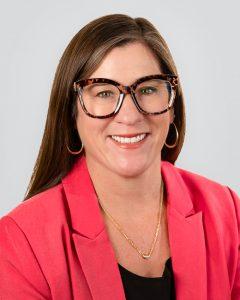FOCUS
Professional learning is key to improving reading
By Shannon Bogle
Categories: Change management, Collaboration, System leadershipAugust 2024
Education systems are making sweeping changes in how they approach literacy instruction as they acknowledge a reading crisis: In the U.S., 45 million adults — five times the population of New York City — cannot read (National Center for Education Statistics, 2019). People who cannot read are at significantly increased risk of dropping out of high school, entering the criminal justice system, and living in poverty (Cree et al., 2022).
This trajectory is established early. Students who are not reading proficiently by 4th grade are far more likely than their peers to struggle in school and life (Snow et al., 1998). It is therefore alarming that, in 2022, 37% of U.S. 4th graders scored below basic on the National Assessment of Educational Progress, often known as “the nation’s report card,” and just a third scored at the proficient level (NAEP, 2022).
States and districts are aiming to change these trends by shifting their instructional approaches to reflect the science of reading, a body of scientific evidence that informs educators and parents about how students learn to read and write.
 It is essential to support teachers' understanding of the science of reading. Their implementation of #HQIM is key to improving literacy outcomes for students of all backgrounds. Share on X
It is essential to support teachers' understanding of the science of reading. Their implementation of #HQIM is key to improving literacy outcomes for students of all backgrounds. Share on X
Literacy instruction grounded in the science of reading focuses on the systematic and explicit teaching of phonics, phonemic awareness, vocabulary, fluency, and comprehension. It prioritizes the foundational skills necessary for decoding and understanding text, aiming to address and prevent reading difficulties more effectively.
The research on how the brain learns to read is not new. The science of reading has accumulated over many years from various disciplines such as psychology, education, and neuroscience. For example, the widely accepted Simple View of Reading framework, developed in the 1980s, draws on research findings that students need to develop both word recognition and language comprehension to achieve reading comprehension (Gough & Tunmer, 1986). Word recognition involves translating a word from print to speech using knowledge of sound-symbol (letter) correspondences, while language comprehension involves making meaning from something heard (oral comprehension) or read (reading comprehension).
Yet, despite the research, schools have been plagued by philosophical debates about reading instruction for decades. Many systems’ recent shift toward applying the principles of the science of reading represents a move away from balanced literacy or whole-language methods that have remained stubbornly popular.
Supporting teachers to understand the science of reading and implement high-quality instructional practices is essential for improving literacy outcomes for students of all backgrounds. Many current teachers and leaders learned about outdated instructional methods — or no literacy instructional methods at all — during their teacher preparation programs. Some have never had access to curricula that have been shown to develop foundational reading skills.
Simply put, schools cannot improve the troubling trends in student literacy without investing in meaningful, sustained professional learning about the science of reading for teachers, leaders, coaches, specialists, and other staff.
As of April 2024, 38 U.S. states and the District of Columbia have laws or policies related to evidence-based reading instruction (Schwartz, 2024). To ensure the success of these efforts, educators need and deserve multifaceted support that involves professional learning, curriculum resources, ongoing support from leaders and coaches, and a collaborative school culture that encourages all staff to improve together.
Fortunately, education leaders can turn to Learning Forward’s Standards for Professional Learning (Learning Forward, 2022) to design and provide support that makes a difference for students. All of the standards work together to ensure high-quality professional learning is effective, regardless of topic or discipline. To help education leaders begin to shape their literacy professional learning, consider how the following Learning Forward standards can support teachers and, ultimately, students.
'' Simply put, schools cannot improve the troubling trends in student literacy without investing in meaningful, sustained professional learning about the science of reading,'' writes Shannon Bogle. Share on X
Simply put, schools cannot improve the troubling trends in student literacy without investing in meaningful, sustained professional learning about the science of reading,'' writes Shannon Bogle. Share on X
Curriculum, Assessment, and Instruction
A crucial component in shifting practice is the availability of high-quality instructional materials and educators’ ability to use them to plan and implement daily lessons. The Curriculum, Assessment, and Instruction standard of the Standards for Professional Learning underscores this, as does the influential publication Transforming Teaching Through Curriculum-Based Professional Learning: The Elements (Short & Hirsh, 2022), both of which draw on research about the value of instructional materials. High-quality literacy instructional materials are designed to provide a structured and systematic approach to teaching reading, ensuring that students build foundational skills in a logical progression.
Districts should start by assessing to determine if the curriculum and materials they are using are high-quality and support the instructional shifts. EdReports is one resource that districts can use to evaluate whether their curriculum supports evidence-based practices. Materials that do not support evidence-based instruction should be abandoned and new ones selected. In districts where teachers are involved in curriculum selection, it is recommended that teachers first engage in foundational learning about the science of reading.
But teachers need more than just initial training on how to navigate the curriculum. They must be engaged in ongoing learning and inquiry, with the curriculum at the center, an approach referred to as curriculum-based professional learning.
In such learning, teachers explore, plan, and practice using the curriculum in teams to ensure the kind of deep and contextualized learning that is required for successful implementation. Curriculum-based professional learning requires that teachers have designated time each week to investigate and plan, using collaborative inquiry as a means of learning and implementation.
High-quality instructional materials are educative, meaning they include support in the form of specific teacher-focused guidance and resources to help teachers learn and prepare for student learning. However, the authors of high-quality instructional materials emphasize that these resources are not meant to be used as scripts.
Rather, teachers who use these resources with integrity, making adaptations based on student needs, see improved student outcomes compared to those who either use them as scripts or deviate too far from the intended outcomes.
Through its Curriculum Equity Initiative, Chicago Public Schools has not only prioritized high-quality instructional materials but has also committed to providing teachers with extensive professional learning centered in the curriculum. This effort is built on recognition that teachers need to buy in to the reasons for and approaches to changed practices as well as support to build their capacity to use those new practices (Hirsh & Ben-Isvey, 2021).
According to data from the Illinois Assessment of Readiness, 31% of elementary school students in Chicago Public Schools were proficient in reading in 2024, compared to 26% in 2023 and 28% in 2019 before the COVID-19 pandemic (Chicago Public Schools, 2024), and an independent study found that Chicago students are recovering from the pandemic in reading skills more quickly than those in most other large districts.
Implementation
Shifting to evidence-based practices aligned with the science of reading requires strategic planning and time. Before any professional learning, leaders strategically plan for implementation, applying change management strategies to help anticipate any challenges or resistance. The Implementation standard articulates the importance of change management strategies, including clearly communicating a vision and the reasons for change, as well as a plan for collective action and clear indicators of progress.
Starting with a theory of change, districts can articulate how professional learning will lead to changes in literacy instruction, which will in turn lead to improvements in literacy instruction, and then to improved student reading outcomes. A simple “if, then” statement allows educators in a district to understand why the shift is happening and what it will ultimately lead to.
Once a theory of change is articulated, system leaders, working with their teams, should develop SMARTIE goals and articulate clear outcomes for literacy professional learning. Most educators have been writing goals in the SMART format for years, ensuring goals are strategic, measurable, achievable, relevant, and time-bound. At Learning Forward, we suggest adding inclusivity and equity to ensure that all educators and students are being considered in the goals (Learning Forward, 2021).
An example SMARTIE goal for implementing structured literacy might read like this:
“Our goal is to implement a structured literacy program across all K-3 classrooms in the district within the next academic year. We aim to achieve a 20% increase in student reading proficiency scores by the end of the year. This will be accomplished by providing professional learning and coaching for teachers, ensuring differentiated support for all students, including those with learning disabilities and English language learners, and equitably allocating resources to close the literacy achievement gap.”
Systems can use the KASAB framework, developed by Joellen Killion (2018), to determine and articulate the specific outcomes to focus on during both the planning and evaluation of the professional learning. KASAB is an acronym for knowledge, attitudes, skills, aspirations, and behaviors of the educators implementing change. The table on p. 41 shows examples of professional learning outcomes organized by the KASAB framework. This kind of a table can help leaders organize their thinking about desired outcomes and then incorporate them into a logic model to develop a coherent plan for change.
Learning Designs and Culture of Collaborative Inquiry
Job-embedded professional learning relies heavily on time and space for collaboration. The Culture of Collaborative Inquiry standard emphasizes the work that must be done beyond a discrete learning event so that educators engage in continuous improvement, build collaboration skills and capacity, and share responsibility for improving learning for all students.
A crucial part of shifting teacher practice is ensuring that they regularly engage in dialogue with their colleagues about the instructional materials they are implementing. Professional learning communities (PLCs) and teacher teams are most effective when they provide teachers with the space and structure to explore their misconceptions about the materials and content, how they will implement that content to best meet their students’ needs, and prioritize the teaching moves for each unit.
Collaborative planning supports the implementation of the science of reading by fostering a shared understanding among educators about evidence-based literacy practices. When teachers work together, they can align their instructional strategies, analyze student data collectively, and develop consistent approaches to teaching reading.
This teamwork enhances professional learning, allows for the exchange of effective techniques, and ensures that all students receive high-quality, research-based reading instruction. Additionally, collaborative planning provides a platform for ongoing reflection and adjustment, which is crucial for meeting the diverse needs of learners and improving literacy outcomes.

Short and Hirsh (2022) point out that certain conditions and structural design elements enable meaningful and collaborative curriculum-based professional learning. One of these elements is time. Teachers who are provided time to work in collaborative teams can make use of the opportunity to annotate lesson plans, rehearse lessons, and analyze student results. With a structured meeting schedule and clear expectations for the use of time, teachers use an inquiry model to improve their use of instructional materials.
Charleston County School District in South Carolina has focused on creating conditions that support the implementation of structured literacy, with the support of Leading Educators. Enabling structural conditions include 300 minutes of planning time per week, 60 minutes of collaborative PLC time per week, quarterly professional learning sessions, and a literacy coach designated full time for each school. With this investment, the district saw a 7.5% improvement in literacy test scores at the district’s most vulnerable schools from 2021 to 2022 (CCSD, 2023).
In my previous work with school district leaders implementing high-quality instructional materials for literacy, our leadership team ensured that teachers had at least one weekly collaborative planning time built into their workday. Additionally, they had a half to a full day of planning for each upcoming classroom module to ensure they had a clear understanding of its purpose and flow, a process often referred to as lesson or module internalization.
Leadership and Learning Designs
Districts need to ensure that district and site-based leaders are knowledgeable and ready to support educators in implementing any new innovation, including improved literacy instruction. Leaders should be equipped to provide guidance, lead data collection and analysis, provide feedback, and coach teachers as they embrace these changes.
Leadership is essential to ensure that the knowledge teachers build in courses, workshops, and coaching is translated into classroom practice in an ongoing way. Research shows that, without ongoing support, new knowledge and skills rarely transfer to the classroom. To get a 75% to 90% chance of successful implementation, educators must have the opportunity to practice, receive feedback, and reflect (Joyce & Showers, 2002).
Of course, district and school leaders cannot facilitate teachers’ learning on their own. They should be part of a team that includes coaches and literacy specialists. Instructional coaches are trained to work alongside teachers to determine areas for improvement, set action steps, collect data to determine changes, and support reflection through coaching conversations, providing feedback as needed. The coach role is layered and complex and includes supporting the planning process as well as conducting coaching cycles around the implementation of what was planned in collaborative planning meetings.
Systems-level leaders should look to the Learning Designs standard to determine how to structure professional learning and whom to engage in that work, and they should be sure to engage leaders, coaches, and all staff in their own professional learning, relevant to their roles.
Learning Forward has been collaborating with the Ohio Department of Education and Workforce literacy team to help with ReadOhio, the state’s plan to raise literacy achievement. We are working alongside regional literacy specialists to create tools that assist districts at all phases of implementation. This effort recognizes that everyone involved, including literacy specialists, benefits from ongoing learning and support.
Evidence
The Evidence standard should be applied at all phases of teachers’ professional learning and implementation of high-quality curriculum and literacy practices. Collecting data is crucial to determining progress (or lack thereof) toward identified outcomes and goals. By gathering and analyzing relevant information, educators can assess the effectiveness of teaching strategies and make informed adjustments to improve results.
Data collection can be considered for initial and intermediate outcomes as well as long-term ones. For example, when collecting data on initial outcomes of teacher use of curriculum, a district might use the Instructional Practice Guides from Achieve the Core (Achieve the Core, 2018) to gauge levels of implementation.
When examining intermediate outcomes of quality and short-term impact, educators may use classroom walk-throughs, formal rubric-based observations, coaching cycles, and student work to determine if both students and teachers are accessing the curriculum with integrity. Finally, data is collected that aligns directly with SMARTIE goals to determine if student outcomes are being positively impacted by the new practice.
Creating an evaluation plan for implementation can provide a structure for how and when these data are collected, considering what data are already available, and what other data sources would be beneficial.
Start with a strong plan
As districts and states make an important shift toward evidence-based reading instruction, it is essential to make a strong and thoughtful plan with high-quality curriculum and high-quality professional learning at the center. Such a plan can help educators at all levels succeed in making a shift that many find challenging because of habitual practices that run counter to the science of reading. Intentionality and support, coupled with patience and ongoing reflection, will support systems in making changes that students so urgently need.
Download pdf here.
References
Achieve the Core. (2018). Instructional practice guide. achievethecore.org/page/1119/instructional-practice-guide
CCSD. (2023, May 5). EL Education curriculum brings learning to life and boosts SC READY scores.
bit.ly/4cPIAzf
Chicago Public Schools. (2024). Chicago Public Schools elementary students post continued gains in reading and math on preliminary 2024 spring state assessment results. bit.ly/3zPaz3s
Cree, A., Kay, A., & Steward, J. (2022). The economic & social cost of illiteracy: A snapshot of illiteracy in a global context. World Literacy Foundation.
Gough, P.B. & Tunmer, W.E. (1986). Decoding, reading, and reading disability. Remedial and Special Education, 7(1), 6-10.
Hirsh, S. & Ben-Isvy, J. (2021). New curriculum demands new support. The Learning Professional, 42(5), 58-61.
Joyce, B. & Showers, B. (2002). Student achievement through staff development. ASCD.
Killion, J. (2018). Assessing impact: Evaluating professional learning (3rd ed.). Corwin & Learning Forward.
Learning Forward. (2022). Standards for Professional Learning. Author.
Learning Forward. (2021). Set a SMARTIE goal to target inclusion and equity. The Learning Professional, 42(6), 66-68.
NAEP. (2022). NAEP reading assessment: Highlights. bit.ly/3zSOrpb
National Center for Education Statistics. (2019). Adult literacy in the United States. Author. nces.ed.gov/pubs2019/2019179/index.asp
Schwartz, S. (2024). Which states have passed ‘science of reading’ laws? What’s in them? Education Week.
bit.ly/3SjBtXO
Short, J.B. & Hirsh, S. (2022). Transforming teaching through curriculum-based professional learning: The elements. Corwin & Learning Forward.
Snow, C.E., Burns, M.S., & Griffin, P. (Eds.). 1998). Preventing reading difficulties in young children. National Academy Press.

Shannon Bogle is the senior director for networks and the academy at Learning Forward. She designs networks and content, builds capacity in state and district educators through network coaching, and manages the strategy and operations for the Academy.
Categories: Change management, Collaboration, System leadership
Recent Issues
BUILDING BRIDGES
December 2024
Students benefit when educators bridge the continuum of professional...
CURRICULUM-BASED PROFESSIONAL LEARNING
October 2024
High-quality curriculum requires skilled educators to put it into...
LEARNING TO PIVOT
August 2024
Sometimes new information and situations call for major change. This issue...
GLOBAL PERSPECTIVES
June 2024
What does professional learning look like around the world? This issue...












